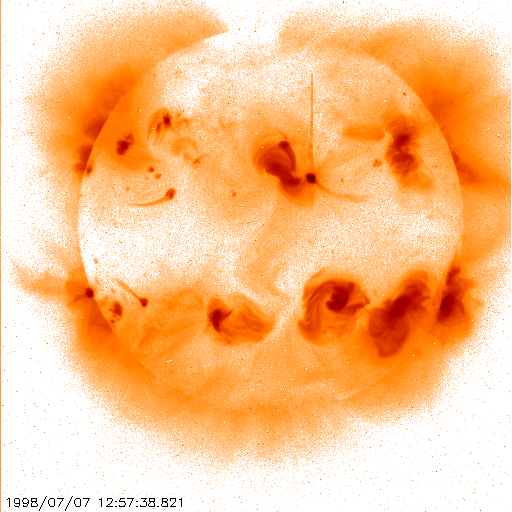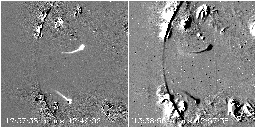An amazing triple jet
Science nugget: July 11, 1998
Phenomenon
The eagle-eyed Sam Freeland has spotted (again) one of the most remarkable
solar phenomena Yohkoh SXT has seen. It consists of three simultaneous
and extremely similar X-ray jets. As you will see in Sam's
movie

The movie shows two frames of the standard SXT movie, which reveal that
at about 12:57 UT on July 7, three curved jets appeared. The lightcurves
peak simultaneously within the sampling, a few minutes. Jet "A" would be
the one at (S21,E45); "B" at (N12,E31), and "C" at about (N17,W13) in the
leading part of NOAA AR 8264, which had been producing many jets. The full-Sun
image shows the geometry. Please ignore the vertical spike extending
N from jet source "C", because this is a saturation artifact.
The jets are different
Yes, these jets are simultaneous; yes, they are curved in curiously similar
and symmetrical ways; yes, they have about the same lengths, but... one
of them seems to have excited a long-lived loop:

These are sequential differences of three images, as noted, and the
second difference shows the jets dark (because they've faded) but jet "B"
shows a bright and fuzzy aftermath, linking the jet bright point to an
active region. There is no obvious remnant from the other two jets.
How probable is this?
Well-developed jets of this quality do not happen too often. If we guess
one per week, and claim that the simultaneity is within five minutes, there
would be a probability of about .0004 for two such events to occur together.
Thus in seven years (350 weeks) of Yohkoh data, we actually would have
a fairly high probability - 15% - of seeing a pair of events. But the probability
drops to 6 x 10^(-5) for three at once. The probability is a lot smaller
for such a beautiful match in properties, of course. Of course this is
a posteriori and one will never know until more examples are found,
but it seems just too extraordinary to be a coincidence.
What does it all mean?
It seems, on the basis of this one observation, that it would be highly
unlikely for emerging flux to arrive simultaneously at positions so far
removed. The limit imposed on the exciter (trigger) speed would be >1000
km/s for a five-minute time difference. This could only be coronal in origin,
not sub-photospheric. This seems to rule out one of the most popular jet
models. But what bizarre MHD effect in the global corona could suddenly
make up its mind to pluck three beautiful jets out of the photosphere at
once? And another question - how do the well-defined curvatures of the
jet structures fit into the quadrupolar structure of the global corona
so well defined by the late lamented LASCO?
H. Hudson (hudson@isass0.solar.isas.ac.jp)


